Najla M Al Shirawi, CEO, Securities & Investment Company, on ways to attract more liquidity to the local bourse:Viewpoint

Relative illiquidity and low free float constitute two key challenges to the growth of the Bahrain Bourse (BHB). One of the main reasons is the low free float in blue chip companies: nine out of the top 15 stocks have a free float of lower than 25%. While it is widely reported that Batelco and Aluminium Bahrain (Alba) have a free float of 23% and 10%, respectively, actual trading volumes imply a real free float of just 2-3%. A low free float makes it difficult to execute large orders without significant market impact.
Another major factor is that Bahrain’s stock index is skewed towards the financial sector, which comprises 73% of total index weight. This lack of sector diversification is discouraging some regional and international investors from investing in the market, since most funds mandates have sector caps. Equally discouraging is the mixed initial public offering (IPO) history. The kingdom has had eight IPOs during the last decade – the most recent being Zain in 2014 – with the share price of most IPOs subsequently trading well below their offer price, leading to cynicism among investors.
The annual traded value of the BHB is only 3% of its market capitalisation of $22bn, which is the lowest in the region. Its annual average daily traded value stands at $2.4m, one-tenth of Oman’s Muscat Securities Market. Bahrain’s benchmark index is one of the most attractive in the GCC on relative valuations, with price-to-earnings and price-to-book value multiples at a discount of 29% and 47%, respectively, to the median for the GCC markets as of January 15, 2015.
This is despite a dividend yield of 4.7%, which is the highest in the region. Low liquidity, float and trading are leading to the discount in Bahrain’s market. Additionally, the majority shareholding in the 10 major companies on the bourse is held either directly or indirectly by the government or by prominent family businesses that hold shares on a buy-and-hold basis.
On the positive side, the enhancement of securities legislation has resulted in IPOs in Bahrain being better regulated than in many GCC countries. However, the drawback of increasing oversight is that IPOs have become more time-consuming and costly for local privately owned companies. Initiatives need be taken to encourage listed companies to divest additional shares in the market through secondary issues on a regular basis, not just as a one-off event.
Privatisation of public and private assets also has a key role to play. Government-owned entities in the energy and utilities sectors could be listed on the BHB. These need to be offered at an attractive discount, potentially with a substantial portion being allocated to Bahraini investors, together with special incentives for retail investors. Another initiative, which has characterised many IPOs in Saudi Arabia since 2008, would be mandatory listing requirements for firms either subsidised by the government or awarded public sector contracts, or those licensed by regulatory authorities.
Changes to the BHB’s index would also help to improve liquidity. The index currently includes all listed companies, many of which do not trade. It would be more reflective if it were to be reconstituted to include just the top five or 10 firms on the bourse. This would have the added benefit of enabling the exchange to lift trading price limits on stocks that have not traded for a long period of time, which contributes to lower liquidity.
Encouragingly, we have already seen the BHB undertaking measures to enhance liquidity, such as the recent set-up of margin trading and market-making rules. It has also approved the trading of options, exchange-traded funds and real estate investment trusts, as well as invested in a new trading engine that enhances options for investors. The bourse helps to launch new products in line with demand. On the primary market front, the Zain IPO in 2014 is the first since Alba’s 2010 issue. The BHB should see more IPOs in the near future, indicating an uptick in capital market activity. These are all steps in the right direction. However, boosting liquidity will require more concrete actions and the concerted efforts of all stakeholders. This process will take time, but will eventually benefit every participant.
You have reached the limit of premium articles you can view for free.
Choose from the options below to purchase print or digital editions of our Reports. You can also purchase a website subscription giving you unlimited access to all of our Reports online for 12 months.
If you have already purchased this Report or have a website subscription, please login to continue.

